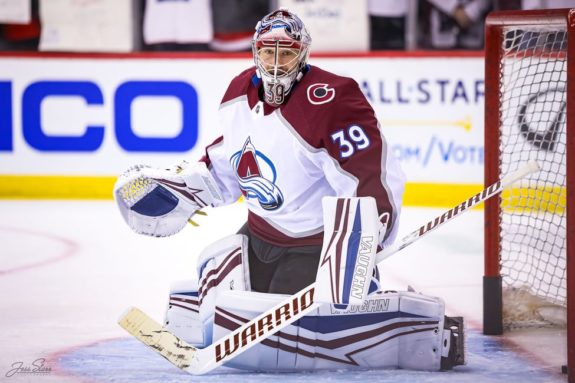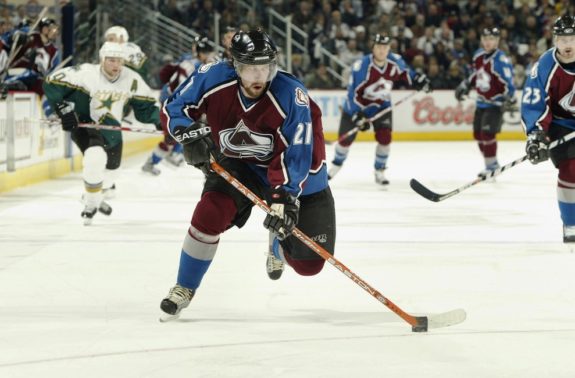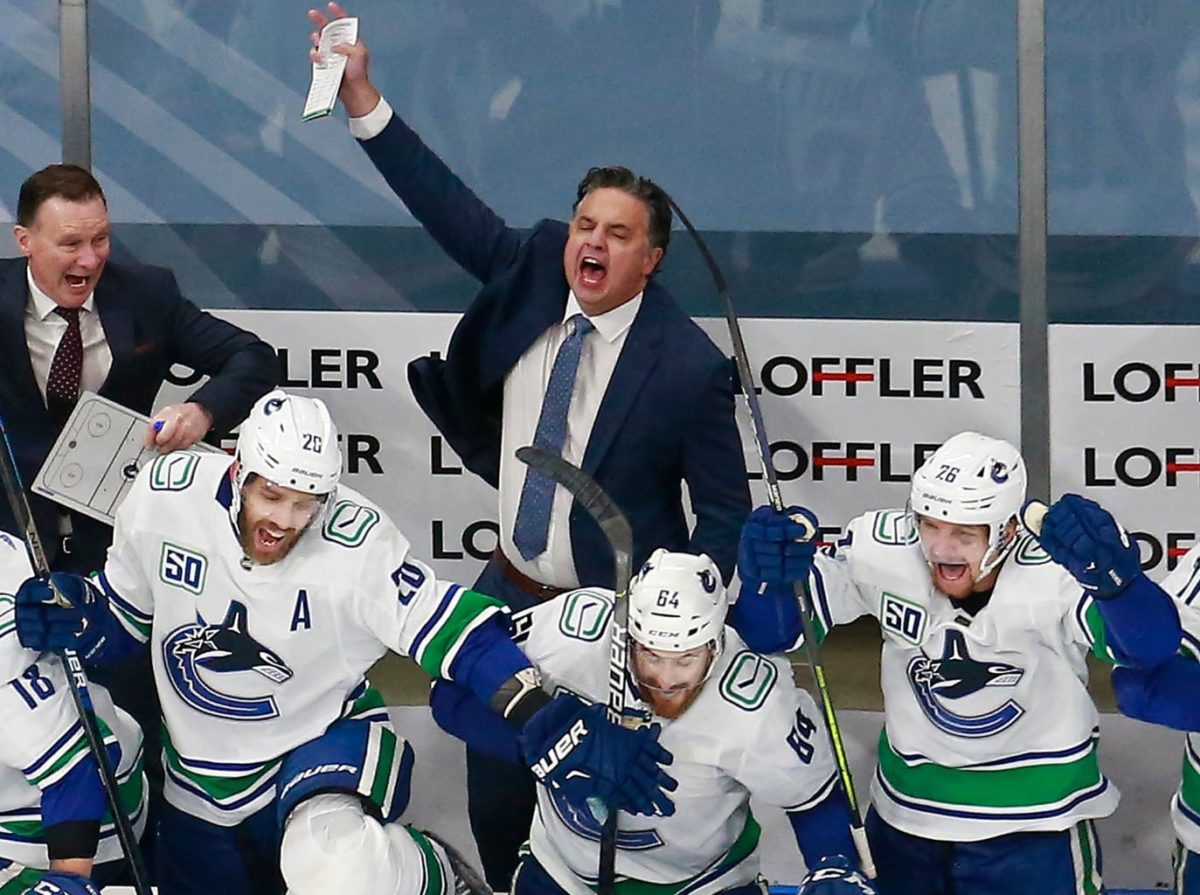Sports rivalries are a reason to circle your calendar, cancel plans and tune in to see who earns bragging rights, makes history and in many cases, gains playoff positioning. But not all rivalries are within their division or conference, which means that the rarity of these matchups makes them even more exciting.
In the NBA, we almost got to see the Los Angeles Lakers reignite their storied rivalry with the Boston Celtics in the 2020 NBA Finals. In the NFL, they usually pit quarterbacks against each other to draw the attention of viewers. And, in the NHL, we have the storied rivalries between the Montreal Canadiens and Boston Bruins, the Pittsburgh Penguins and Philadelphia Flyers, the Edmonton Oilers and Calgary Flames, and the Vancouver Canucks have their fair share of rivalries, but there is a current interconference rivalry brewing that many hockey fans may not be aware of — the Canucks and the Colorado Avalanche.
If the Canucks and Avalanche were able to best their second-round 2020 Stanley Cup Playoff opponents, the Dallas Stars and Vegas Golden Knights, this bubbling rivalry would have become a topic of discussion this offseason. Alas, they were unable to, and as a fan of both teams, I’d like to share an impartial analysis of some of the contributing factors that will make this interconference rivalry an exciting one for years to come. And no, we’re not revisiting the Steve Moore incident.

Whenever these teams play, the hockey world has been treated to an onslaught of goals that often extends the game into overtime and as a result, I believe that an ensuing rivalry is brewing.
Let’s look at a few contributing factors that not only tie these two franchises together but also ignite the flame of competition and entertainment.
H2H Factor
The first factor to consider when analyzing a rivalry is the head-to-head record. If one team dominates the other, then it isn’t much of a rivalry. That is not the case here. These teams are trading wins in high scoring close games, and to show you, let’s look at the previous three seasons, beginning with 2019-20.
The first time the Canucks and Avalanche met during the shortened NHL season of 2019-20 was on Nov. 16, 2019. In the game, the players posted nine goals in an entertaining overtime win by the Avalanche (5-4). Later in the season, on March 6, 2020, the Canucks split the season series by a score of 6-3 when the Canucks’ third line of Adam Gaudette, Antoine Roussel and Zack MacEwen absolutely lit up the Avalanche’s backup goalie, Pavel Francouz.

During the 2019-20 season matchup, the Canucks started Thatcher Demko in both games while the Avalanche goaltenders were Antoine Bibeau and aforementioned Francouz. Should the Av’s luck turn this upcoming season with the return of Braden Holtby’s former understudy, Philipp Grubauer, they may be able to make a few more crucial saves, but that may not actually help. The last time Grubauer played in the rivalry, the final score in one of the most exciting games I have ever seen awarded the Canucks a 7-6 overtime win.
The next two times these teams would meet, both in February 2019, the final scores were split with the Canucks winning 5-1 and then the Avalanche coming away with a win of 3-2. However, it is worth mentioning that in those games neither starting goaltender was with the club (Jacob Markstrom and Semyon Varlamov).
During the 2017-18 season, these teams met twice in January 2018, where both games ended in overtime by the scores of 4-3, Canucks, and 5-4, Avalanche. About a month later, the Avalanche won the rubber match in regulation 3-1.
When you look back at these previous eight matchups, the Canucks and Avalanche are tied at four wins apiece, but the Canucks have the goals for advantage of a combined 33-29.
So, if you’re a fan of high-scoring games, this is definitely a bubbly rivalry worth watching.
Longevity Factor
Whenever these teams play next, there will be five former Calder Trophy winners on the ice. It begins with Tyler Myers (2009-10) who won his while playing with the Buffalo Sabres, and the Avalanche team captain, Gabriel Landeskog (2011-12), balances the score and 1-1. Then, Hart Trophy candidate Nathan MacKinnon (2013-14) and current Canucks superstar, Elias Pettersson (2018-19) even it out at two apiece. But it’s last season where the Avalanche got the 3-1 advantage, and sorry Canucks fans, this one may sting. Cale Makar (2020), who narrowly beat out Quinn Hughes for the title of rookie of the year (ROY), gives the Avalanche the advantage for now.

Because of the close discrepancy in votes and similar playing styles, Makar and Hughes may be forever compared to each other, thus adding fuel to the fire in this rivalry that’s loaded with young talent. It’s also worth noting that the Avalanche passed on 2018-19’s ROY, Pettersson, to select Makar at fourth overall in the 2017 NHL Entry Draft.
Now, just because the Av’s have the lead in Calder Trophy winners, doesn’t mean it will remain that way. The Canucks have a few special players coming up, and two in particular will make a strong case towards ROY honours and balance the Calder Trophy players between the A’s and C’s.
Looking at the longevity factor, Myers and Landeskog are no longer considered young, but these teams still boast enough young talent to keep the rivalry alive. Some of whom, not included in this list of Calder Trophy winners, are Mikko Rantanen, Bo Horvat and Brock Boeser, all of which will have long careers in the NHL. If they stick with these teams, it’ll certainly keep the rivalry alive and well for a long time.
Forsberg Factor
As a boy, Pettersson may have dreamed of playing for the Canucks, but it may come as a surprise who the young Swede modelled his game after.
In a recent podcast of Spittin’ Chiclets, Pettersson was asked, “when you were younger, were there any Swedish born hockey players that you modelled your game after? You could score and pass equally good, I would say Peter Forsberg – I know he probably had a little more grit to his game – but who did you model yourself after?” Yes, Pettersson’s response was baited, but he affirmed that number one, was the former Avalanche superstar, Peter Forsberg.
“Yeah, first one was Peter Forsberg, I just remember his old days back in Modo,” said Pettersson before throwing a jab at host Ryan Whitney, which unfortunately derailed a possibly riveting story of childhood adulation.

Before the podcast, we already knew that Pettersson was a fan of Forsberg. Most of you may remember this Forsbergian one-handed deke that he pulled off against the New Jersey Devils back in 2019.
The Forsberg Factor ties these two factions together further and adds a little bit of spice to the rivalry whenever Avalanche general manager Joe Sakic invites his old friend and linemate to games.
It would certainly be interesting to watch these teams play with Forsberg observing in the stands. I’d imagine a display of showmanship by Pettersson as a sign of respect to his Swedish countrymen.
Front Office Factors
With both teams being built on finesse and skill, let’s have a look behind the bench. Where the Canucks head coach, Travis Green who was drafted into the NHL, played from 1990-2008, whereas the Avalanche head coach, Jared Bednar went undrafted and never suited up for the NHL. This added experience gives Green one or 18, depending on how you look at it, additional factor(s) over Bednar.
Each former player turned head coach provides their club with experience and will continue to battle it out in this high-scoring rivalry as long as they’re with the team. However, here is where Bednar gets another score — he was chosen over Green to become the head coach of the Avalanche. (from ‘Travis Green linked to Avalanche coaching gig,’ The Province, 08/16/2016).
As general managers go, the Canucks’ Jim Benning was a former player who became a scout and later assistant general manager for the Bruins squad that won the Stanley Cup championship in 2011. On the other side, the Avalanche has the legendary Sakic as general manager and executive vice president. On both sides, the front office factor includes a lot of experience and hardware, which is just another reason to circle your calendars as soon as the 2020-21 schedule is released.

At the risk of making this rivalry analysis the length of a Stephen King novel, let’s pause it for now and revisit these factors within the year. Once these two offensive juggernauts have played a few more times, who do you think will have the head-to-head advantage? Let us know in the comments below and if you’d like to include any additional factors, please share.